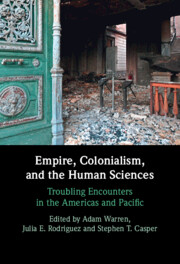10 results
1 - Introduction
-
-
- Book:
- Empire, Colonialism, and the Human Sciences
- Published online:
- 24 October 2024
- Print publication:
- 07 November 2024, pp 1-28
-
- Chapter
-
- You have access
- Open access
- HTML
- Export citation

Empire, Colonialism, and the Human Sciences
- Troubling Encounters in the Americas and Pacific
-
- Published online:
- 24 October 2024
- Print publication:
- 07 November 2024
-
- Book
-
- You have access
- Open access
- Export citation
New principles to live by: and a change of skin
-
- Journal:
- Australian Journal of Environmental Education / Volume 40 / Issue 3 / June 2024
- Published online by Cambridge University Press:
- 18 October 2023, pp. 525-536
-
- Article
-
- You have access
- Open access
- HTML
- Export citation
Looking into the border. Whiteness, (un)desirable encounters and research containment at the Spanish–Moroccan border
-
- Journal:
- Libyan Studies / Volume 54 / November 2023
- Published online by Cambridge University Press:
- 11 July 2023, pp. 45-54
- Print publication:
- November 2023
-
- Article
-
- You have access
- Open access
- HTML
- Export citation
Jovian encounter manifolds
-
- Journal:
- Proceedings of the International Astronomical Union / Volume 18 / Issue S382 / December 2022
- Published online by Cambridge University Press:
- 16 October 2024, pp. 180-184
- Print publication:
- December 2022
-
- Article
-
- You have access
- Open access
- Export citation
3 - Architecture of Encounters
- from Part I
-
- Book:
- Islamic Law in Circulation
- Published online:
- 24 March 2022
- Print publication:
- 31 March 2022, pp 102-124
-
- Chapter
- Export citation
Introduction
-
- Book:
- Contact Zones of the First World War
- Published online:
- 17 August 2021
- Print publication:
- 26 August 2021, pp 1-15
-
- Chapter
- Export citation
The Refugee Camp as Site of Multiple Encounters and Realizations
-
- Journal:
- Review of Middle East Studies / Volume 54 / Issue 2 / December 2020
- Published online by Cambridge University Press:
- 07 July 2021, pp. 215-233
- Print publication:
- December 2020
-
- Article
- Export citation
Dragomans, tattooists, artisans: Palestinian Christians and their encounters with Catholic Europe in the seventeenth and eighteenth centuries
-
- Journal:
- Journal of Global History / Volume 14 / Issue 1 / March 2019
- Published online by Cambridge University Press:
- 14 February 2019, pp. 68-86
-
- Article
- Export citation
Mimesis and rivalry: European empires and global regimes*
-
- Journal:
- Journal of Global History / Volume 10 / Issue 1 / March 2015
- Published online by Cambridge University Press:
- 18 February 2015, pp. 77-98
-
- Article
- Export citation

